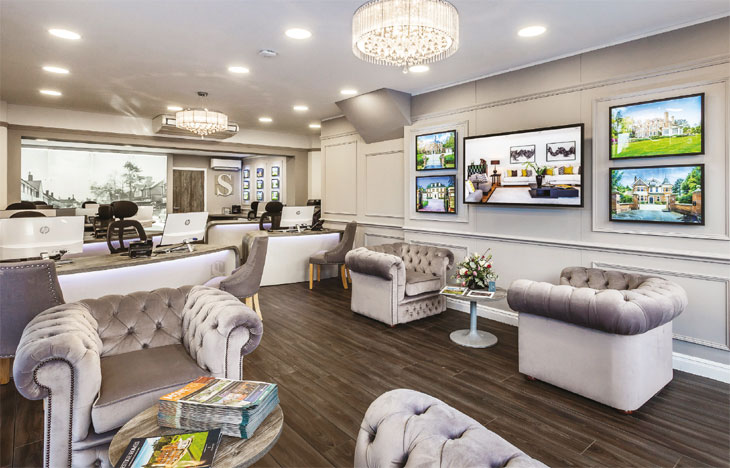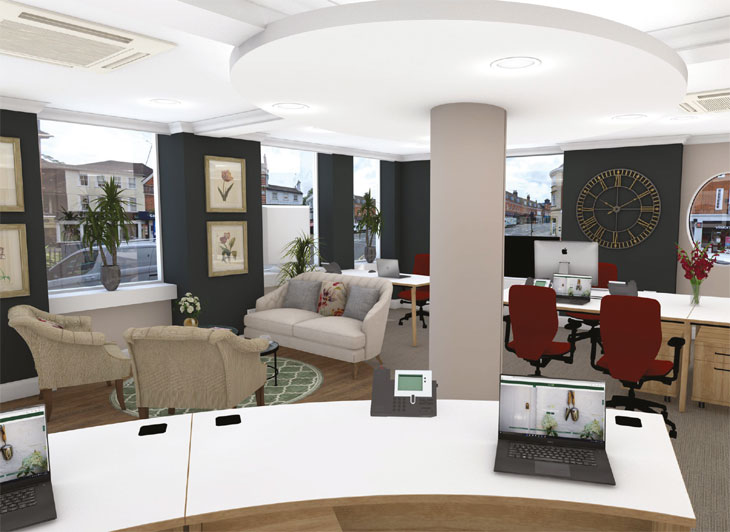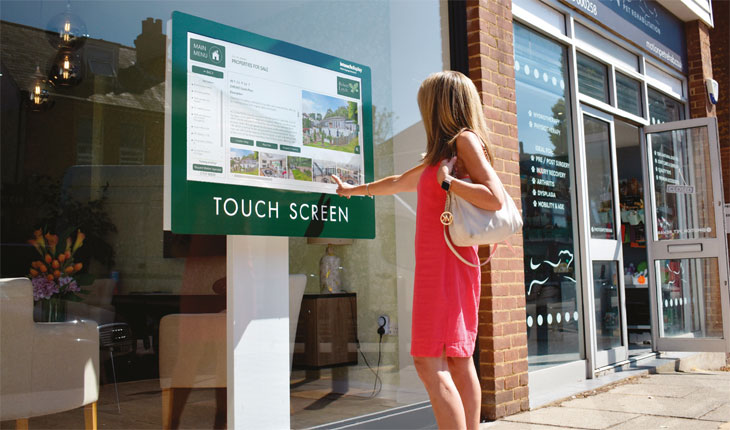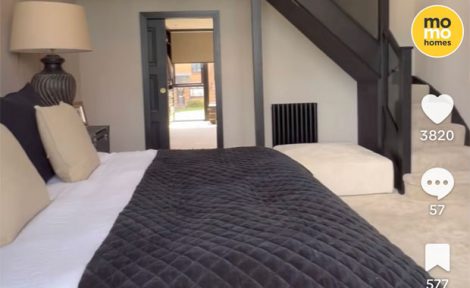Window shopping
To borrow from Mark Twain, reports of the death of the high street estate agency have been grossly exaggerated. In fact, they are thriving, as Richard Reed reports.

Except the anticipated tsunami never happened. Purplebricks foundered and was flogged off for £1. And agents are doubling down on their investment in high street premises with office refits and digital display technology.
 So what changed? The answer, according to the experts we spoke to, is simple: it’s all about the vendor. “Although every search begins on Rightmove, every listing begins in the high street,” says Brett Sidaway, Group Marketing Manager at Mid West Displays. “The agent you decide to list with, you will have noticed in the high street.
So what changed? The answer, according to the experts we spoke to, is simple: it’s all about the vendor. “Although every search begins on Rightmove, every listing begins in the high street,” says Brett Sidaway, Group Marketing Manager at Mid West Displays. “The agent you decide to list with, you will have noticed in the high street.
Estate agents have become less formalised – if you didn’t see the sign you wouldn’t know it was an agent, it’s much more relaxed and casual. Brett Sidaway, Mid West Displays.
“Vendors want to see their beautiful home displayed in a fit fashion. When vendors are walking the high street and see displays which make property look good, they are drawn to those particular agents. Buyers don’t care, they go on the internet and see everything they need to.
“Vendors increasingly want to see their property shown in a smart, high-impact way.”
 Embedding in the subconscious Andrew Waugh, Project Manager at Excite Interiors, agrees. “When people go to sell a house they look for a name that is familiar. If you’ve got a presence on the high street you are going to be seen by people every time they go to the high street. So you are going to be in their mind subconsciously when they are looking for someone to sell their property.”
Embedding in the subconscious Andrew Waugh, Project Manager at Excite Interiors, agrees. “When people go to sell a house they look for a name that is familiar. If you’ve got a presence on the high street you are going to be seen by people every time they go to the high street. So you are going to be in their mind subconsciously when they are looking for someone to sell their property.”

There’s lots of competition with agents… so you’ve got to be looking your best, looking professional and looking like you’re go to be able to sell their property. Andrew Waugh, Excite Interiors.

The industry has moved away from having rows of desks with two chairs in front of the negotiator’s table.
 According to Steve Blackaller, Sales Manager at touchscreen supplier InTouch Display, it’s vital that you stand out from the crowd. “The market is tightening and people need to know how the agent is going to actively promote their properties. Doing that over the phone is fine, but it’s always better to see the whites of their eyes and really get a feel about how they are going to attack the marketing of their homes,” he says.
According to Steve Blackaller, Sales Manager at touchscreen supplier InTouch Display, it’s vital that you stand out from the crowd. “The market is tightening and people need to know how the agent is going to actively promote their properties. Doing that over the phone is fine, but it’s always better to see the whites of their eyes and really get a feel about how they are going to attack the marketing of their homes,” he says.
The market is tightening and people need to know how the agent is going to actively promote their properties… it’s always better to see the whites of their eyes. Steve Blackaller, InTouch Display.

 It’s the same message from Mark Evans, founder of screen installer Halo Digital Signage. “When you consider the ticket price of property, it’s the biggest purchase of your life – there’s a trust factor in being face-to-face with someone.
It’s the same message from Mark Evans, founder of screen installer Halo Digital Signage. “When you consider the ticket price of property, it’s the biggest purchase of your life – there’s a trust factor in being face-to-face with someone.
“There is sometimes a relationship that can come from noticing something in a window. It can help trigger a deeper dive on the property and obviously you have a point of reference on the high street and it adds credibility to the business.”
To stand out from the competition there’s no better way than a number of screens with good quality content. It’s not just the screen, it’s the content. Mark Evans, Halo Digital Signage.
New look for offices
Looks certainly do count when it comes to the presentation of that high street office.
 “We have carried out extensive research on who invests in their offices. It’s a big driver on many levels – image and branding, market position, staff retention and street presence,” says Steve Leah, director and designer at Visual Communications Design.
“We have carried out extensive research on who invests in their offices. It’s a big driver on many levels – image and branding, market position, staff retention and street presence,” says Steve Leah, director and designer at Visual Communications Design.
We have carried out extensive research on who invests in their off ices. It’s a big driver on many levels – image and branding, market position, staff retention and street presence. Steve Leah, Visual Communications.

“Start-ups seem more focused on attracting the best staff and providing a great place for them. Existing agents are building on their reputation by opening new offices and taking market share and the top five in the area want to improve or maintain their market position.”
He says staff are key to being the dominant agent in the area. “Great staff want great environments that reflect their ambitions so they feel a sense of pride when clients visit the premises.”
When it comes to street presence, he emphasises that it’s a “numbers game”. “You are dealing with the subconscious mind, not the conscious mind. It only takes two people a minute to pass your shop to create over a 1,000,000 subconscious impressions a year, so keep the external elevation clean and simple.”
Leah points out that most major homebuying decisions are made by lady of the house, and says he designs offices from this perspective.
Consumer-friendly interior
Excite’s Waugh agrees that building market share is a major consideration with office refits. “There’s lots of competition with agents – most towns have five or six – so you’ve got to be looking your best, looking professional and looking like you’re go to be able to sell their property.”
He says most agents are now going for a comfortable, consumer-friendly interior where vendors will feel comfortable talking to negotiators. “The look is now to look more like a living room, a lot more friendly and cosy so you feel you can go in there and have a chat without being looked down upon,” he explains.
Perhaps prompted by Covid, the industry has moved away from having rows of desks with two chairs in front of the negotiator’s table – now vendors are met when they come into the office and taken to a meeting area where you can have an informal discussion. Desks are still on view, but further back, with a comfort zone at the front of the office and plenty of room to move around. “They are trying to get away from the look of a customer walking in the door and having eight pairs of eyes staring at them,” adds Waugh wryly.
It’s a trend that Sidaway has noticed, too. “Estate agents have become less formalised – if you didn’t see the sign you wouldn’t know it was an agent, it’s much more relaxed and casual,” he says.
There has also been a trend to making offices more friendly and comfortable for staff – “people are putting more effort into the kitchen and toilets,” notes Waugh.
Video displays
There has been another, very noticeable change in the ‘look’ of the traditional estate agent’s office: the appearance of large video displays. And for ‘large’, think up to seven feet in size – the largest that Excite has installed is a staggering 84 inches. Waugh s ays screens are being increasingly used as part of a window display, although he adds that traditional property pockets are still very much in demand.
InTouch Display specialises in installing touchscreens, which passers-by can use while standing outside an agent’s office, regardless of whether it’s open or not. Steve Blackaller explains that an interactive touch foil on the inside of the window allows you to navigate the software through the glass. He says agents who have installed the screens are getting an average of 40 users per week, while the office of Cole Rayment and White in Padstow is getting in excess of 100 users per week.
InTouch has also seen “exponential” growth over the past 18 months in the installation of non-touchscreen displays. These bright, daylight-readable digital screens feature a rolling carousel of an agent’s properties, often with useful local information about community organisations and charity events.
Portrait-mode screens
Interestingly, as many as 70% of agents are opting to have displays orientated in portrait or ‘phone’ mode – “It looks a little bit more ‘retail’ and ties in with other screens that are being displayed in phone shops, travel agencies and that kind of thing,” explains Blackaller.
One 75-inch display the company installed for Breckon and Breckon in Bicester proved such a head-turner that within a fortnight the firm had ordered two more for its offices in Summertown and Abingdon.
“The MD just couldn’t believe it,” says Blackaller. “He said, ‘We took the vinyl off the window and the first 50 people I watched walk past it looked straight at that screen because of the size of it.’” It’s about being seen, he emphasises. “If cars are backing up at traffic lights, what do people do? If you got a really bright impactful screen with a bit of video going on, it’s a powerful subliminal message. You are showing vendors how you will be displaying their properties – ‘You instruct us and your property is going to be on this huge bright screen as well as Rightmove.’”
Content can be customised as the agent sees fit, and either selected directly from the CRM database or provided by the installer to the customer’s specifications. “One agent in Dunstable has a coffee morning next door once a week, so every Tuesday from 10 to 12 he puts up his retirement properties on screen,” notes Blackaller.
Standing out on the street

Over at Halo, Mark Evans agrees that portrait mode is a popular way to go.
“We do a lot of 65-inch screens in landscape, but you might want to put a few smaller screens in portrait in your window. We are not saying get rid of tent cards, they serve a purpose, but use a window to reach and engage an audience from further afield and stand out on the street.”
He reports that feedback from agents suggests that digital signage can boost sales by up to 30%. “It’s so important because at the end of the day you are amplifying what you are saying in your window,” he explains.
“Traditional window pockets are very small and you are really only reaching people who are passing on foot. But what sits beyond that, what about the traffic – what about the person on the bus?
It’s about catching attention and then pulling them into your business – when the business is closed.
“It’s about catching attention with a bigger net and then pulling them into your business, and that working when the business is closed.” Evans says business is booming, and that digital signage has become a key part of the marketing mix.
“What I say to my customers is you’ve got all your marketing inventory – and everybody focuses on spending online, pay per click and organic searches – but you’ve got a natural resource in your office. Agents are very adept at picking the right brand and the right location for their branch but they don’t extend the reach of the biggest, most powerful marketing tool at their fingertips, which is their windows.”.
Not just about size
It’s not just all about size, however, especially with 72-inch sunlight-readable screens coming in at around £7,500, installed – you could buy two 55-inch screens for that price. It’s how you use that digital real estate that really counts, though.
Mark Evans; “To stand out from the competition there’s no better way than a number of screens with good quality content. I can’t stress that enough – it’s not just the screen, it’s the content and how you deliver that content. It’s got to be the right software that allows you to be really adept and flexible and agile with your content.”
QR codes offer another opportunity for passers-by to interact with an agent’s shop window. If someone sees a property the like, they can scan the QR code on their phone, and it will connect them to the website and they will be able to see the property on the screen.
Watching a virtual tour on a seven-footer is quite a cinematic experience. “There’s movement, there’s theatre going on, and that works really well,” notes InTouch’s Blackaller.
Evans agrees, “It’s part and parcel of that experiential engagement. Your business is working for you even when you’re closed – you’re turning your shop window into an extension of someone’s laptop or phone.”
Competition is heating up

Competition has always been tough in estate agency, but there are signs it’s going to get harder still over the next few years, and Mid West’s Sidaway believes that creating a standout brand has never been more important.
“All those guys that wanted to set up and thought they could operate in an upstairs room with a bank of telephones are now realising they have got to get into the high street and that will make it even tougher for all estate agents,” he warns.
It’s perhaps an unexpected twist, but shows the traditional estate agent model is alive and kicking in the high street.





